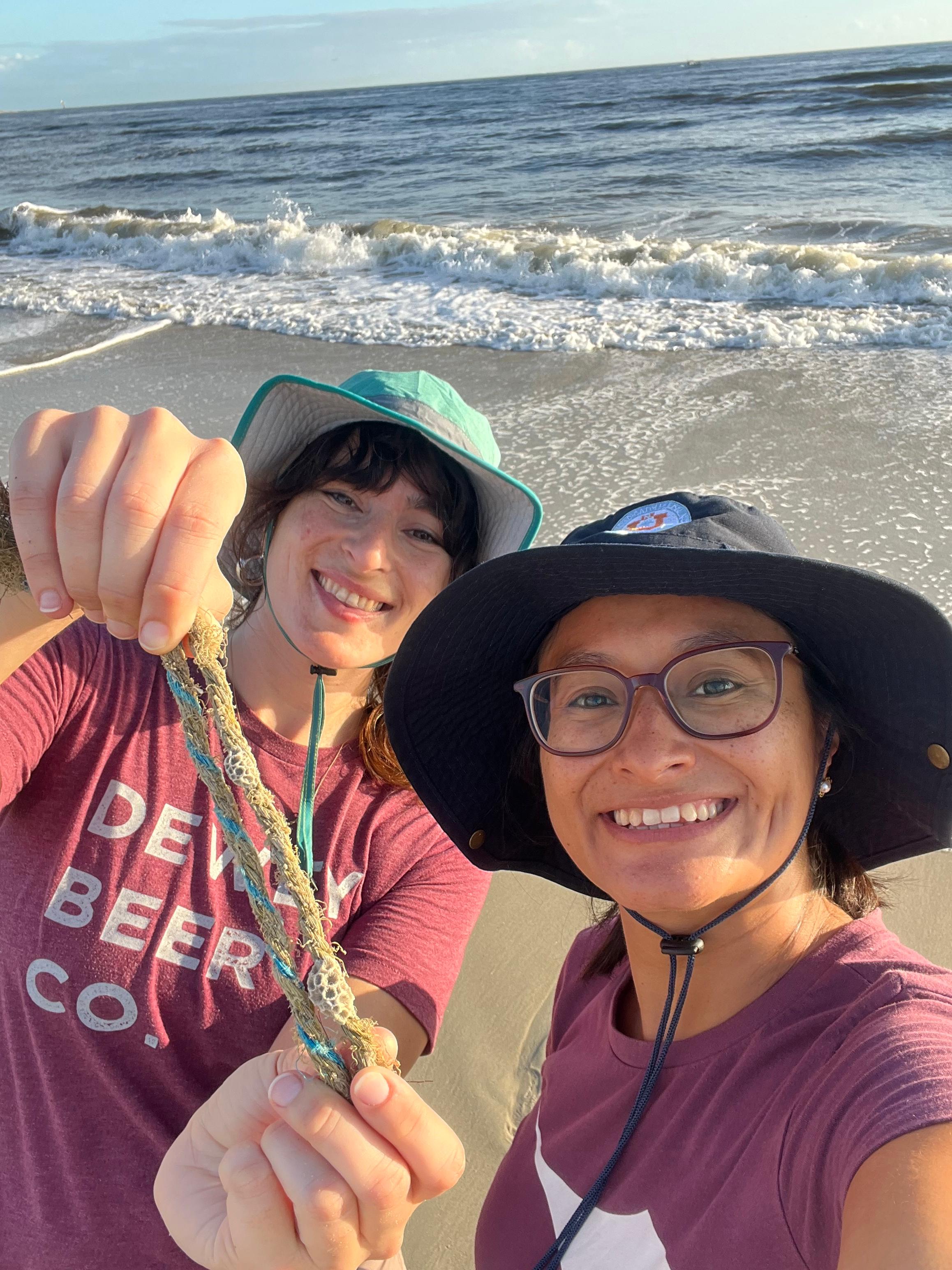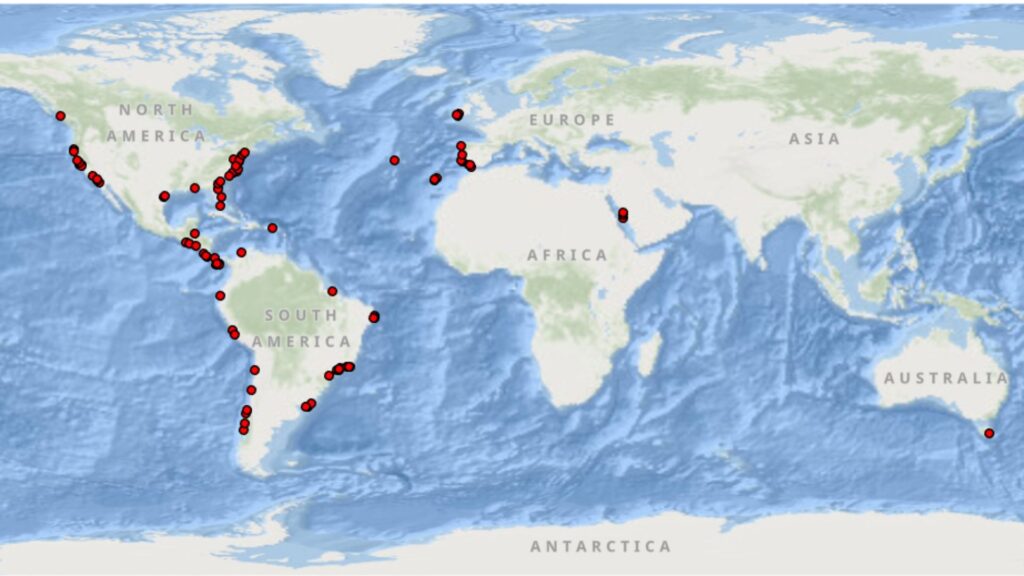by Erin Minor

Many marine organisms, like barnacles, bryozoans and algae, spend their lives on other living creatures floating in the sea. But today, some of them are finding new homes to colonize: plastic pollution. Ocean Travelers is a participatory science project, where volunteers and scientists track marine organisms living on litter that washes ashore. Run by the Smithsonian Environmental Research Center (SERC), the project hopes to determine whether invasive species are spreading via litter in the ocean.
Marine biologists Martin Thiel, Jim Carlton and Greg Ruiz started the first Ocean Travelers at SERC in 2022. They wanted to understand what organisms were living on plastic in the ocean, and how far they were spreading. It was born of a collaboration between different programs around the world, including the Smithsonian-led MarineGEO that monitors the world’s coastal ecosystems and Científicos de la Basura, based out of Chile. Ocean Travelers I was a huge success, recruiting volunteers, local teachers and their students to collect samples on the beach with professional scientists.
The Plastic Tide
Ocean Travelers I sought to answer two basic questions: What kinds of organisms live on marine litter? Where do they appear? To find out, more than 2,000 volunteers sampled litter on 475 beaches in 56 countries.
“There are certain areas that receive a lot of litter with organisms from the ocean and other areas that receive much less,” said Thiel.
While Ocean Travelers I generated important knowledge, each beach represented only a single snapshot. Do the same beaches always receive the same amount of organism-coated trash? Or does this vary over time? Diamela De Veer, a postdoctoral fellow at SERC, became interested in these questions and joined the Ocean Travelers team.
In 2024, De Veer led the sequel project: Ocean Travelers II. The second episode added a new layer of information—tracking plastic pollution over time. This past year, volunteers collected samples every three months to understand if the litter or organisms on it changed by season. This is a higher time commitment to ask of volunteers. As a result, more of the participants were professional scientists who agreed to help with this project in their free time. This also meant they had to reduce the number of sample sites. Ocean Travelers II contained 112 sites across 20 countries, roughly one-fourth of the sites in Ocean Travelers I.

The team just finished collecting the fourth and final round of samples from Ocean Travelers II. Official results are still pending. But scientists are already seeing signs that non-native species are spreading on marine litter.
“I still have to sort through the most recent round of data before we have any official findings,” said De Veer. “But we have identified some species of acorn barnacles that are not native to where the litter was found.”
Waves of Volunteers
Hundreds of volunteers participated in each of the four rounds of sampling. After collecting the litter washed up on beaches, they then sorted it by type (plastic, metal, glass, etc.), whether the item floated, and if there were organisms on it. After writing all of this information down, the volunteers took photos of the litter to submit to the scientists at SERC, who could validate the data for accuracy.
To make sampling as easy as possible for volunteers, De Veer wrote a protocol with step-by-step instructions and pictures.
“Diamela and Martin led trainings to walk people through the sampling protocols in English and in Spanish, which is the first time MarineGEO has done protocols in Spanish,” said Katelyn DiBenedetto, MarineGEO program manager. “It was great to see how much effort went into making sure the project was inclusive.”
One major benefit from this project is not only in the scientific findings, but the public engagement that occurred along the way. The participants now have training and experience with this method of scientific sampling.
“The Ocean Travelers II project has provided us with an opportunity not only to conduct scientific research, but also to gain knowledge that will last a lifetime,” said Raul Batista, a high school teacher in Panama who participated in the project.
Another group from Brazil even took the initiative to do their own study. During their participation in Ocean Travelers I, they noticed that a lot of their litter was coming from the Democratic Republic of Congo, all the way across the ocean. They went on to use these methods to conduct a study tracking where the litter on their beaches originates.
“They can now use this method and do their own studies – they don’t need us,” said Thiel.

The Ocean Travelers Trilogy
Scientists are already working on a third installment: Ocean Travelers III. The goal for Ocean Travelers III is to more clearly answer questions about species identification. Scientists often have a difficult time identifying species based on the images volunteers submit. Different barnacle species can look alike. Sometimes, the only way to tell two barnacle species apart is a close look at a very specific part of their bodies. If the photograph doesn’t capture those differences, it can be difficult or impossible to accurately identify it.

To address this problem, the Ocean Travelers team plans to go to universities to train professors and their students to accurately identify these species. These universities will be at four central locations throughout South America, where they can send physical specimens for clearer identification.
Despite its wide geographic spread, this project still has limitations. They can only study organisms that leave behind an exoskeleton on litter. If any soft-bodied organisms lived on that piece of plastic, their tissue would likely have degraded by the time the plastic hit the shore. Additionally, any mobile organism on the litter can simply crawl away when it gets washed ashore. This leaves a wide possibility for other currently unknown species spreading via marine litter, and an area rife for more research.
But ultimately, the scientists said, this is an issue of reducing the amount of waste in the ocean.
“If litter is available, some species are going to attach to [it] and travel with [it], whether they are native or not,” said De Veer. Invasive species aren’t the only hazard of marine pollution. But they show another unintended side effect that’s exacerbated by our waste ending up in the ocean.
Dive Deeper:
3 Animals Helping Us Track Plastic Pollution in the Ocean
Do We Live in the Plasticene? 12 Words to Know for the Age of Plastics.
Ocean Plastic Is Creating New Communities of Life on the High Seas
These Creatures Crossed the Pacific on Plastic Tsunami Debris. Now, a New Struggle for Survival.

